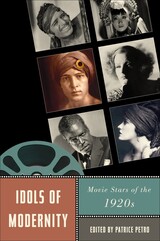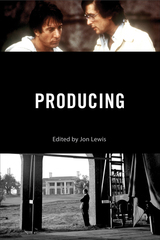3 books by Rapf, Joanna E.

Cinematic Canines
Dogs and Their Work in the Fiction Film
McLean, Adrienne L
Rutgers University Press, 2014
Dogs have been part of motion pictures since the movies began. They have been featured onscreen in various capacities, from any number of “man’s best friends” (Rin Tin Tin, Asta, Toto, Lassie, Benji, Uggie, and many, many more) to the psychotic Cujo. The contributors to Cinematic Canines take a close look at Hollywood films and beyond in order to show that the popularity of dogs on the screen cannot be separated from their increasing presence in our lives over the past century.
The representation and visualization of dogs in cinema, as of other animals, has influenced our understanding of what dogs “should” do and be, for us and with us. Adrienne L. McLean expertly shepherds these original essays into a coherent look at “real” dogs in live-action narrative films, from the stars and featured players to the character and supporting actors to those pooches that assumed bit parts or performed as extras. Who were those dogs, how were they trained, what were they made to do, how did they participate as characters in a fictional universe? These are a just a few of the many questions that she and the outstanding group of scholars in this book have addressed.
Often dogs are anthropomorphized in movies in ways that enable them to reason, sympathize, understand and even talk; and our shaping of dogs into furry humans has had profound effects on the lives of dogs off the screen. Certain breeds of dog have risen in popularity following their appearance in commercial film, often to the detriment of the dogs themselves, who rarely correspond to their idealized screen versions. In essence, the contributors in Cinematic Canines help us think about and understand the meanings of the many canines that appear in the movies and, in turn, we want to know more about those dogs due in no small part to the power of the movies themselves.
The representation and visualization of dogs in cinema, as of other animals, has influenced our understanding of what dogs “should” do and be, for us and with us. Adrienne L. McLean expertly shepherds these original essays into a coherent look at “real” dogs in live-action narrative films, from the stars and featured players to the character and supporting actors to those pooches that assumed bit parts or performed as extras. Who were those dogs, how were they trained, what were they made to do, how did they participate as characters in a fictional universe? These are a just a few of the many questions that she and the outstanding group of scholars in this book have addressed.
Often dogs are anthropomorphized in movies in ways that enable them to reason, sympathize, understand and even talk; and our shaping of dogs into furry humans has had profound effects on the lives of dogs off the screen. Certain breeds of dog have risen in popularity following their appearance in commercial film, often to the detriment of the dogs themselves, who rarely correspond to their idealized screen versions. In essence, the contributors in Cinematic Canines help us think about and understand the meanings of the many canines that appear in the movies and, in turn, we want to know more about those dogs due in no small part to the power of the movies themselves.
[more]

Idols of Modernity
Movie Stars of the 1920s
Petro, Patrice
Rutgers University Press, 2010
With its sharp focus on stardom during the 1920s, Idols of Modernity reveals strong connections and dissonances in matters of storytelling and performance that can be traced both backward and forward, across Europe, Asia, and the United States, from the silent era into the emergence of sound.
Bringing together the best new work oncinemaand stardom in the 1920s, this illustrated collection showcases the range of complex social, institutional, and aesthetic issues at work in American cinema of this time. Attentive to stardom as an ensemble of texts, contexts, and social phenomena stretching beyond the cinema, major scholars provide careful analysis of the careers of both well-known and now forgotten stars of the silent and early sound era—Douglas Fairbanks, Buster Keaton, the Talmadge sisters, Rudolph Valentino, Gloria Swanson, Clara Bow, Colleen Moore, Greta Garbo, Anna May Wong, Emil Jannings, Al Jolson, Ernest Morrison, Noble Johnson, Evelyn Preer, Lincoln Perry, and Marie Dressler.
Bringing together the best new work oncinemaand stardom in the 1920s, this illustrated collection showcases the range of complex social, institutional, and aesthetic issues at work in American cinema of this time. Attentive to stardom as an ensemble of texts, contexts, and social phenomena stretching beyond the cinema, major scholars provide careful analysis of the careers of both well-known and now forgotten stars of the silent and early sound era—Douglas Fairbanks, Buster Keaton, the Talmadge sisters, Rudolph Valentino, Gloria Swanson, Clara Bow, Colleen Moore, Greta Garbo, Anna May Wong, Emil Jannings, Al Jolson, Ernest Morrison, Noble Johnson, Evelyn Preer, Lincoln Perry, and Marie Dressler.
[more]

Producing
Lewis, Jon
Rutgers University Press, 2015
Of all the job titles listed in the opening and closing screen credits, producer is certainly the most amorphous. There are businessmen (and women)-producers, writer-director- and movie-star-producers; producers who work for the studio; executive producers whose reputation and industry clout alone gets a project financed (though their day-to-day participation in the project may be negligible). The job title, regardless of the actual work involved, warrants a great deal of prestige in the film business; it is the credited producers, after all, who collect the Oscar for Best Picture. But what producers do and what they don’t or won’t do varies from project to project.
Producing is the first book to provide a comprehensive overview of the roles that producers have played in Hollywood, from the dawn of the twentieth century to the present day. It introduces readers to the colorful figures who helped to define and reimagine the producer’s role, including inventors like Thomas Edison, moguls like Darryl F. Zanuck, entrepreneurs like Walt Disney, and mavericks like Roger Corman. Readers also get an inside look at the less glamorous jobs producers have often performed: shepherding projects through many years of development, securing financial backers, and supervising movie shoots.
The latest book in the acclaimed Behind the Silver Screen series, Producing includes essays written by seven film scholars, each an expert in a different period of cinema history. Together, they give readers a full picture of how the art and business of producing films has changed over time—and how the producer’s myriad job duties continue to evolve in the digital era.
[more]
READERS
Browse our collection.
PUBLISHERS
See BiblioVault's publisher services.
STUDENT SERVICES
Files for college accessibility offices.
UChicago Accessibility Resources
home | accessibility | search | about | contact us
BiblioVault ® 2001 - 2024
The University of Chicago Press









